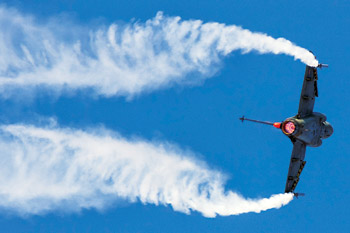INDIAN ARMED FORCES CHIEFS ON
OUR RELENTLESS AND FOCUSED PUBLISHING EFFORTS

SP Guide Publications puts forth a well compiled articulation of issues, pursuits and accomplishments of the Indian Army, over the years

I am confident that SP Guide Publications would continue to inform, inspire and influence.

My compliments to SP Guide Publications for informative and credible reportage on contemporary aerospace issues over the past six decades.
- Prime Minister witnesses 'Bharat Shakti' – a Tri-Services Firing and Manoeuvre Exercise in Pokhran, Rajasthan
- Interim Defence Budget 2024-25 — An Analysis
- Union Defence budget 2024
- Prime Minister Modi Commemorates Indian Navy Day in a Grand Ceremony
- Prime Minister Modi Flies in the LCA Tejas
- New Chapter in India-Italy Defence Ties
- Airpower beyond Boundaries
Modernisation of the Armed Forces
Are the Indian armed forces adequately equipped to confront the challenge posed by Pakistan or more importantly, by Pakistan and China acting in collusion?
 |
By Air Marshal B.K. Pandey (Retd) Air Officer Commanding-in-Chief of Training Command, IAF |

Hostile activity by elements in the Pakistan-occupied Kashmir (PoK), inimical to the security interests of the nation either by themselves or with active support by the not-so-friendly neighbour Pakistan, has been on the rise especially in recent times. In response to the terror strike by the Pakistan-supported elements on an Indian military base in Uri on September 18, 2016, in which 19 Indian soldiers perished, the Special Forces of the Indian Army carried out a ‘surgical strike’ with notable success. However, there was an inelegant attempt by the opposition to gain political mileage from the surgical strike and put the BJP government on the backfoot. But what is of concern is that instead of a salutary effect of the surgical strike on the enemy, the hostile elements have become even more aggressive and active all along the line of control. While the Kashmir Valley continues to burn with ever-increasing ferocity, ceasefire violations by Pakistani forces remain unabated and casualties amongst Indian forces have been on the rise.
It is abundantly clear that the Kashmir Valley is India’s Achilles’ heel and Pakistan will leave no stone unturned to exploit this weakness through proxy war. As India is not in a position to repay Pakistan in the same coin, the most appropriate response would be a massive retaliation by conventional forces to be delivered as a crushing blow. The question is whether the Indian armed forces are adequately equipped to confront the challenge posed by Pakistan or more importantly, by Pakistan and China acting in collusion.
As per media reports, at the Air Force Commanders’ Conference, Air Chief Marshal B.S. Dhanoa, Chief of the Air Staff of the Indian Air Force (IAF), directed the commanders to “prepare for short duration, but intense wars of 10 days in case of Pakistan and 15 days with China to maintain razor-sharp operational preparedness and enhanced combat effectiveness.” The precise state of operational preparedness, however, can be assessed only after a thorough evaluation of threats and challenges the nation faces, assets available for combat and capability of support elements.
Unless the government accords the right priority towards timely and systematic modernisation of the Indian armed forces, allocates the funds required and restructures the DPP to address proactively the imperatives of national security, the capability of the armed forces will remain undermined.
From the information available in the public domain, as against the requirement of 45 combat squadrons to cope with a two-front war, the IAF currently has 32 squadrons, 10 squadrons short of the authorised strength of 42 squadrons. Efforts were on by the IAF since 2002 to acquire under the newly crafted Defence Procurement Procedure (DPP), a modern fourth-generation combat platform in large numbers. The Rafale aircraft from Dassault Aviation was selected but owing to insurmountable impediments, the project was finally abandoned in 2015. So much for the procurement process! Partial relief to the IAF was provided by a direct deal with the French Government for 36 Rafale jets to be delivered by 2020. Meanwhile, the IAF will phase out a few squadrons of MiG-21 and MiG-27 aircraft that are already obsolete. The rate production of the light combat aircraft (LCA) Tejas Mk I and IA is extremely low and it may take well over a decade for the IAF to induct the six squadrons that are on order. The more capable LCA Mk II is nowhere on the horizon.
Meanwhile, the Ministry of Defence initiated a project to manufacture in India with collaboration with a foreign original equipment manufacturer (OEM), a reputed single-engine fighter aircraft. The platform selected was the F-16, a product from Lockheed Martin of the United States. The OEM is prepared to transfer its only existing production line in the US to India and manufacture the Block 70 version which is the latest, in large numbers for the IAF as also for other customers across the globe. For the IAF this was the proverbial light at the end of the tunnel. However, nearly a year has passed since the proposal was initiated, but the project appears to be shrouded in uncertainty on account of the policy imperatives of the Donald Trump administration. Meanwhile, the combat fleet of the IAF continues to dwindle.
The plight of the Indian Army is no better. While addressing a defence think tank recently, General Bipin Rawat, Chief of the Army Staff (COAS), said, “Spending on defence is considered a burden by many in the country and the military is not getting its due share.” This statement by the COAS is an indication that the Indian Army may not be equipped well enough to fight a full-scale war.
Unless the government accords the right priority towards timely and systematic modernisation of the Indian armed forces, allocates the funds required and restructures the DPP to address proactively the imperatives of national security, the capability of the armed forces will remain undermined.





